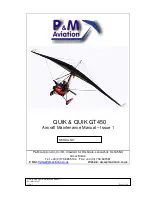
3
SERVOS
Because of the size and weight of the Pitts Python, standard servos do not produce enough
torque for high performance aerobatics or 3-D flight. The following are the minimum
torque requirements for this level of performance:
Ailerons:
80 oz-in.
Elevators:
80 oz-in.
Rudder:
100 oz-in.
Throttle:
Standard servo
Choke:
Standard servo
CAUTIONS
Gas engines, because of the ignition systems, require some special care. The ignition is
capable of producing radio interference that can shorten the range of the radio gear.
To help minimize these problems use the following recommendations: Never use a solid
wire for throttle control, use Nyrod or other plastic nonconductor. Keep all radio gear at
least 12 inches from all ignition components, such as battery, switches, wiring and the unit
itself. If a servo is used to operate the ignition on/off switch, do not mount the switch at the
servo, instead use a piece of Nyrod and a remote switch bracket. Be sure spark plug wires
are shielded and the shield is properly grounded to the engine. Follow the engine
manufactures instructions. Large powerful servos have a higher power consumption rate
than standard servos, for this reason it is important the battery selected be capable of
supplying the required amperage. The switch harness must also be of the heavy-duty type.
A lightweight switch may overheat and fail under high loads.
ASSEMBLY
If you are familiar with the assembly of ARF type airplanes, you will find the following
assembly sequence to be unusual. The sequence was designed to speed assembly by
incorporating the radio gear installation in the workflow. Please follow the assembly
instructions as written. The Pitts Python will take approximately 25 hours to complete
Read each step of the instructions carefully. Be sure you understand what is required and
what the procedure is before you glue or cut anything. How well you assemble this model
will have a direct effect on its flight characteristics. In several sections, we have added
HINTS to assist in construction
PLEASE also note:- A
Fuel Tank has Not been included
due to the fact that a variety of
engines can be used, each one requiring a different tank size to achieve desired flight times.
Also
, we have not included wheels
. It has been found that most modelers who construct
this size of aircraft throw away the kit included wheels and install their own.






























